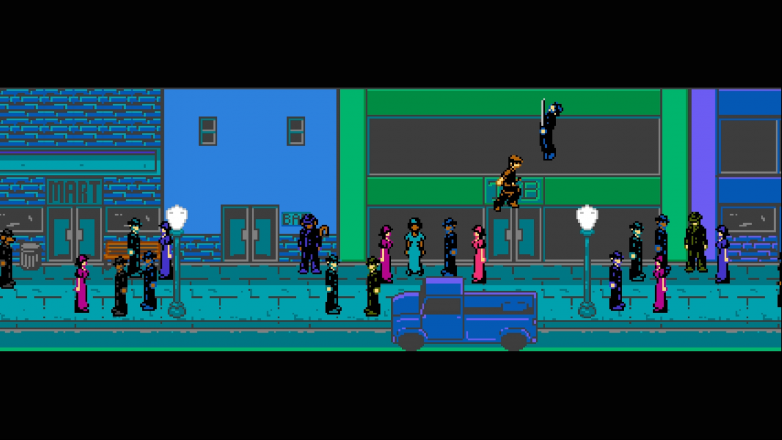Release “date” is a new series where I take a newly-released game and spend some quality time with it. I will then give my first impressions based on the time I’ve spent with the game. My lovely partner today is Shin Samurai Jazz, a game by Blaze Epic. I’ve spent close to two hours with this game, and I’m ready to give my impressions.
Shin Samurai Jazz is an adventure-platformer. What drew me to take a look at this title was its claim of a film noir style coupled with an electro-jazz soundtrack. I found this combination to be quite compelling and decided to pick the game up and see what it had to offer. Unfortunately, I was immediately disappointed by the lack of variety in the soundtrack of the game. The developer describes himself as an electronic musician, yet there are very few different tracks in the game, which is unfortunate. I find that in difficult games, especially platformers, the soundtrack variety is what keeps me motivated to complete the level. It prevents me from getting too frustrated and provides a nice change of pace to performing the same action over and over again. Also, the enemy variety was very lackluster from what I’ve seen. I’ve only experienced five different types of enemies in my time with Shin Samurai Jazz, not including the two boss fights I encountered. Although some of the enemy design (ghosts? with elongated necks who headbutt you and flying, fireball-shooting women) was very interesting, I would have preferred to see maybe two or three types of enemies in each location. This would have made the areas stand out a bit more, as I often found myself forgetting whether I was in the apartments, office, or theater as many of the environments shared similar themes. However, considering the $.99 price point of the game, re-use of assets is to be expected and I can look past it without much of an issue. Something to consider, however, is that I did run into two bugs in my two hours of play time that caused my character to disappear which forced me to reload an old save and have to repeat a level that I had almost completed. Keep that in mind when decided whether or not to try the game out.

In the very beginning of Shin Samurai Jazz, I found myself completely lost when it came to the story of the game. The game presents you with a widescreen view of a street and pastes text into the large black bars that are around the screen during non-gameplay sequences. Fantastic, except for the fact that some of the text overlapped, making it unreadable, and the conversations had no indication of who was speaking or any context of what they were speaking about. I quickly moved past this to try to get into some actual gameplay so that I could experience what Shin Samurai Jazz had to offer. The first thing I noticed was that the game features a sort of overworld, where you can enter various buildings (most of which are closed off until the appropriate story sequence is reached). There was a market that you could visit when you wanted to save your game, and three slots in which to save your game, which is always a nice feature. After saving my game, I entered the first building, and my first platforming sequence. I played with the keyboard and mouse controls for a few minutes, and then decided it was best to plug in my gamepad, which I should have done from the start considering the game is a platformer. After plugging in the gamepad, I experienced a noticeable improvement in my movement and jumping abilities, which is to be expected. The controls are fairly simple to understand, X button to swing your sword and use the left stick to aim your swing, and A to jump. There is also a double jump ability, as well as a dash ability that you can perform in the air to help you reach those more difficult areas and complete the more challenging jumps. The platforming felt surprisingly good, as I enjoyed jumping along walls, between spike traps, and dodging arrows flying out from traps. The controls always felt responsive, and I never felt like I was a victim of an unfair death. On the other hand, I felt like the fighting mechanic was a bit clunky at times, as the reach of your sword is difficult to predict and it is impossible to tell whether or not an enemy attack is able to be blocked without just testing it out. An issue I had during combat was the lack of a health meter of any kind. This made it difficult for me to gauge whether I should be aggressively attacking the enemies, or keeping back, blocking, and timing my attacks in a more strategic way.

All in all, I think that Shin Samurai Jazz is a fun platformer that can give you a couple of hours of entertainment for a very low price tag. I was surprised by the solid platforming controls, and I found the visual aesthetic to be quite interesting. Although I was a bit lost when it came to the story, I feel like a few more hours of play time may clear up some of the questions that I had. If you are even the slightest bit a fan of platformers, I would recommend picking up Shin Samurai Jazz, as the low price makes it a fair addition to any gamer’s library. Although Shin Samurai Jazz may not be perfect, there is definitely a good bit of fun to be had jumping around and slashing enemies to the good (although frequently looping) soundtrack.
 Load the Game Video Games, Reviews, Game News, Game Reviews & Game Video Trailers
Load the Game Video Games, Reviews, Game News, Game Reviews & Game Video Trailers



